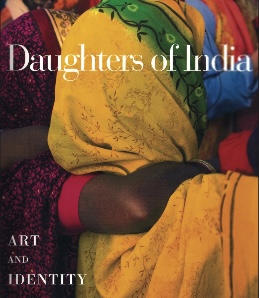BY TARA KATIR
INDIA’S WOMEN
Stephen Huyler is well known to us from his previous books on India: Village India, Gifts of Earth, Meeting God–Elements of Hindu Devotion and Painted Prayers. His newest book, Daughters of India–Art and Identity, is visually beautiful, emotionally sensitive and an intelligent look into the everyday lives of twenty Indian women, of several religions and living in various locations throughout India and abroad. Huyler writes, “The women of India have long been misperceived in the West. Abuse towards women pervades Indian society, as it does in many parts of the world, but this abuse must be regarded with its own context. Much of Western reportage about Indian women is misinformed or misguided, depicting all or most of them as victims. Terrible inequities within Indian society must be addressed and changed, but it is essential that Indian women also be recognized for their strengths and for the phenomenal abilities to rise above adversity. India’s cultures are contradictory–a fact epitomized by the conflicting attitudes towards women.” Huyler’s work is an attempt to correct these misrepresentations while giving a voice to some of India’s five hundred million women. Through their words and his amazing photographs, he has captured their strength and profound dignity. Some may view the stories and see these women as victims. However, Mr. Huyler says, “The chapters are not profiles of victims, but of women demonstrating strength, fortitude, dignity and spirit.” Complete with full color photographs, Daughters of India is an extraordinary look into their lives. This book should help to bring understanding and respect to the most significant part of Indian society today, her women. daughters of india–art and identity, abbeville press publishers (www.abbeville.com), 137 varick st., new york, new york 10013, pgs 263, $65.00
GIFTS OF THE HARAPPANS
We come now to an archeological study that showcases the ingenuity, creativity, science and technology of the past: Harappan Architecture and Civil Engineering by Jagat Pati Joshi. The Harappan civilization flourished during the 3rd and 2nd millennia bce, reaching its peak around 2600, shortly after the development of Mesopotamia and Egypt. Professor Joshi writes, “Like the other Old World Civilizations, the Harappan civilization seems to have grown from the skillful utilization of the fertile river systems and their valleys in the northwestern region of the Indo-Pakistan subcontinent. Systematic town planning, fortification of citadel, elaborate drainage system the idea of establishing granaries and surplus economy, standardization of brick sizes, weights and measures, geometric instruments (e.g. right angles, linear scale and plumb bob) are the principal gifts of the Harappans to succeeding cultures. It was the Harappans who gave the idea of welfare of the workers for the first time. Different types of hydraulic architecture is another legacy of the Harappans, besides many others in social, economic and religious fields.” Illustrated with maps, drawings and photographs, this scholarly study is a fascinating and long overdue look at this ancient civilization. The Western educational view has focused on Mesopotamia and Greece as the “cradle of civilization,” ignoring the larger and equally advanced civilizations in the Indian subcontinent and China. This biased view of history is coming to an end. The Infinity Foundation’s support of Professor’s Joshi’s academic efforts is applauded, as is the work itself, which is available at Amazon.com. harappan architecture and civil engineering by jagat pati joshi rupa & co., 7/16 ansari road, daryaganj, new delhi 110 002, india, 218 pgs, $15.11
A BIOGRAPHY OF MUKTANANDA
Swami Prakashananda’s book Baba Muktananda–A Biography looks into the life of an extraordinary human being. Swami Muktananda Paramahamsa, affectionately called Baba by his devotees, was known by millions worldwide at the time of his Mahasamadhi in 1982. Swami Prakashananda has written a compelling portrait of this saintly soul. From his mother’s devout prayers at the Manjunath Siva Temple in Mangalore, South India, seeking Siva’s Grace for a child, to Baba’s world travels, Swami provides us an intimate look into the life of this modern-day saint. Baba was born May 16, 1908. By the age of 15 he had frequently seen the sadhu Nityananda, who lived an austere life in the Kadri Hills of South India with a sect of Natha yogis. An intense face-to-face meeting took place in 1923, changing the course of Baba’s life. A deep yearning for a life of spirituality took precedence, and he left home forever to pursue an inner journey. Swami’s account of Baba’s early life is interspersed with amazing stories of Nityananda, (who would become Baba’s guru) life at Ganeshpuri, and Baba’s travels throughout India and the United States. Included in this marvelous biography are many precious black and white photos of Baba and his guru, Nityananda. Baba’s spirituality inspired thousands of people. Through Swami’s book, that darshan continues to flow to the world baba muktananda–a biography by swami prakashananda, sarasvati productions, 1625 hollingsworth dr., mountain view, ca 94040. e-mail: email@sarasvatiproductions.com 382 pgs, $23.95


